The Fortis team is scientists, writers, clairvoyants, ufologists, who have gathered together with one goal: to unravel the secrets of the Russian land.
Strong not only in spirit and physically, but also in knowledge, many areas of which today are only opening up to the thinking part of humanity.... Read more...
Survival in anomalous zones
Poisonous plants of the middle zone
On an expedition, no matter how long or difficult it may be, you may need plants: as food, tea leaves or medicines external and internal use. However, before you reach out to a pretty bush, make sure that this plant is familiar to you. And it is especially important that from childhood a person learns as many plants as possible and learns to understand them. Otherwise we will end up sad famous case, when an eight-year-old boy, having eaten some unknown berries in the forest (his parents didn’t even notice how it happened, only his cousin saw it, but then she also couldn’t show what kind of berries they were!), made his way back in an ambulance " Unfortunately, he was not saved. An eyewitness to the incident cousin, grew up with a phobia of wild plants and managed to instill it even in her children. Well, as long as they remain city dwellers, they are probably not in danger. But what will happen if one day they have to come into contact with wild nature?! Of course, it would be better not to. Otherwise there will be laughter... well, laughter, not tears!
So, in order for you and your children to avoid such a sad fate, we advise you to start getting acquainted with wildlife with poisonous plants, which you must avoid in every possible way on your way, be sure to show what they look like at different periods of their life. life cycle(from sprout to fetus), to children and to achieve a stable avoidance reflex from them.
Although... buttercups, for example, collected in a bouquet, are very beautiful and last a long time in a vase. And, by the way, they are not dangerous at all. But - let them only be in a bouquet!
So, let's start getting acquainted with poisonous plants that are found quite often in the Russian Federation.
Wolfsbane (Wrestler)IN middle lane There are two most common species of this plant in Russia: the woolly borer and the oak borer. All parts of the plant are deadly poisonous. The first symptoms of poisoning appear within a few minutes: numbness of the tongue, burning in the mouth, cramps in the limbs, loss of vision, vomiting. |
|
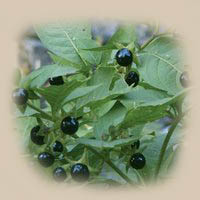
|
A perennial plant from the nightshade family. It grows mainly in the south of the country, but is also found in the middle zone. All parts of the plant are poisonous. The first symptoms of poisoning appear within a few minutes: dry mouth, photophobia, visual disturbances, hallucinations, increased heart rate. Subsequently, convulsions and mental agitation begin. Death occurs from respiratory paralysis. Belladonna berries are the most common poisoning. |
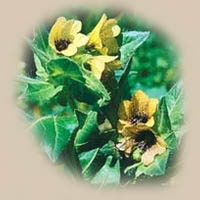 |
Henbane blackGrows throughout Russia. The plant has a characteristic pungent odor. The symptoms of poisoning are the same as those of belladonna. |
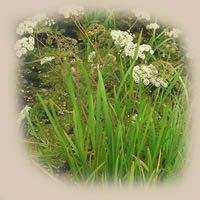 |
Veh poisonousPerennial plant of the Apiaceae family. It grows in swampy areas and on the banks of reservoirs throughout the European part of Russia. The plant contains cicutotoxin, which causes a fatal central nervous system disorder. Signs of poisoning appear immediately after consumption: nausea, vomiting, dizziness, pain in the stomach, dilated pupils, and later - convulsions, paralysis of the limbs and death. |
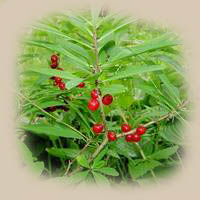 |
Wolf's bast (wolf berry)A shrub growing in the European part of Russia. The flowers are pink, reminiscent of lilac. The fruits are red berries, tightly clinging to the trunk. The berries have an unpleasant, burning taste and are extremely poisonous. Symptoms of poisoning: burning in the mouth, nausea, vomiting, acute gastroenteritis (inflammation of the stomach), bloody diarrhea. The juice of the plant, if it comes into contact with the skin and mucous membranes, can cause severe irritation. |
 |
Hemlock spottedBiennial plant of the Apiaceae family. Distinctive feature- brown spots at the bottom of the stem. All parts of the plant are poisonous, but the immature seeds contain the maximum amount of toxic substances. The first symptoms of poisoning: nausea, vomiting. In severe poisoning, heaviness in the legs, profuse salivation, dilated pupils (often uneven), blurred vision, numbness of the limbs, paralysis and death from respiratory arrest occur. |
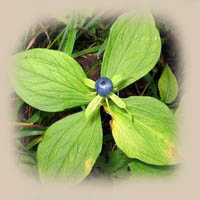 |
A perennial plant widely distributed in the European part of Russia. The most poisonous is the single berry of the plant. Symptoms of poisoning: nausea, vomiting, dizziness. In case of severe poisoning, heart failure may occur. |
 |
Distributed in the European part of Russia, as well as in Western Siberia. The most poisonous are the berries and rhizomes. The sap of the plant causes irritation and inflammation of the skin. When eating berries, nausea, vomiting, and breathing problems occur. |
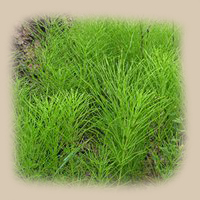 |
This perennial from 10 to 40 cm tall. Stems are 1.5-4 mm in diameter with branches directed obliquely upward. . Very poisonous to cattle, horses and pigs. |
 |
Datura commonAn annual plant from the nightshade family. Found in southern regions Russia. The most dangerous are the small black seeds. Symptoms of poisoning: redness of the face and neck, dilated pupils, dry mouth, thirst, swelling of the palate, hallucinations, subsequently loss of orientation, mental agitation, convulsions and loss of consciousness. |
Poisoning by dangerous plants is a very common phenomenon. The reason for this is basic ignorance poisonous herbs. Some of them are so toxic that the sad consequences of contact with them will not take long to appear, even from ordinary touching or inhaling the smell. One of prominent representatives Such plants are henbane.
What does black henbane look like?
In order not to make a mistake when meeting this plant and to avoid poisoning, it is better to get to know it theoretically. Black henbane will be quite recognizable if you study the description of its characteristic appearance, and perhaps this will help protect you from dangerous consequences.
Black poisonous henbane- A 2-year-old plant of the nightshade family, it has an unpleasant odor. It reaches a height of 0.6, and in some places up to 1.4 m.
The henbane root is thickened and taprooted. It is sometimes compared to parsley root due to its external similarity, only the size differs.
The stem is straight, with many branched shoots. The plant (stem and leaves) is covered with sticky fibers, creating a soft and velvety feeling when touched.
The leaves are large and serrated. Their color is dark green on the upper side, and slightly lighter on the back, with a silvery tint.

The flowers are collected at the top and have a tubular-bell-shaped shape. Its petals are yellowish-white, with big amount dark purple specks and veins. The core is thickly inky, almost black (there are suggestions that it was a flower with this color that gave the name to the plant - black henbane).
Flowering time is from the second half of May to mid-autumn, in some places only from June to August.
The fruit is a capsule with a lid on top, containing many small brown seeds, similar to poppy seeds. Their number in one box can reach 500.
It is the henbane fruit that is often the cause of poisoning in children who mistake the seeds of a poisonous plant for poppy seeds.
Area
Black henbane is unpretentious. It grows almost everywhere, but is most widespread in the following countries and continents:
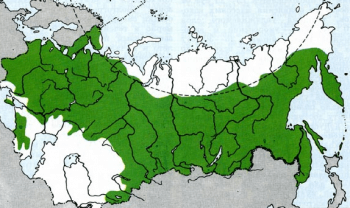
- North America;
- Australia;
- countries Central Asia;
- Baltics;
- Ukraine;
- countries of Western Europe;
- some African countries.
In Russia, this poisonous plant has taken root everywhere except the northernmost regions. It prefers fertile soils, but, in principle, it does well in less comfortable conditions.
Places where you can see henbane are garbage heaps, vacant lots, the edges of fields and vegetable gardens, along highways (like many wild plants). It hardly grows densely, mostly only in small groups or alone.
In nature, there are several types of henbane related to black henbane: tiny, reticulated, red, poisonous and white henbane. Each of these plants is poisonous.
Plant characteristics
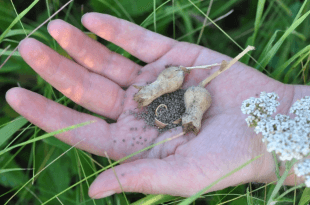
Black henbane is completely poisonous, from the roots to the very top. The seeds of the plant are especially dangerous. Also, even its toxic smell can lead to poisoning if you inhale it for some time.
The plant contains alkaloids, of which atropine and scopolamine are recognized as particularly dangerous. In addition to alkaloids, phospholipids, steroids, and fatty acids were found in the seeds.
Scopolamine is essentially a narcotic substance, the effects of which lead to confusion, incoherent speech, and hallucinations. People call it “truth serum”, because scopolamine is actually included in its composition, making a person weak-willed and obedient. Chronic exposure to the alkaloid leads to complete amnesia.
Atropine is a plant alkaloid that can cause psychosis, loss of coordination, hallucinations, and disorders of the respiratory and cardiovascular systems. Just 100 mg of atropine one time - and a person may not have time to save.
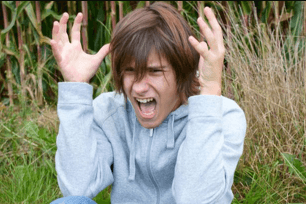
Both of these alkaloids are strong psychotropics that cause inappropriate behavior and severe poisoning. It is not for nothing that people call black henbane besiv, mad blekota, witch grass, foolish grass, etc.
But what is dangerous cannot always be only harmful. Oddly enough, pharmacognosy describes black henbane as a plant widely used for medicinal purposes.
Read also: Poisoning and overdose of celandine
Use in medicine
In addition to dangerous alkaloids, the composition of “night blindness” (another popular name henbane) includes glucosides, essential and fatty oils, proteins, gum, sugar. The top of the stem, leaves, roots and seeds of the plant are used to make medicines.
In precisely calculated small doses, black henbane, like some other poisonous plants, has a healing effect on the body:
- painkiller;
- reduces intoxication after the bite of an animal with rabies;
- anthelmintic;
- antispasmodic;
- soothing, etc.
Preparations containing substances contained in black henbane have found their use in the following diseases:

- bronchitis, pneumonia and asthma;
- pediculosis;
- myositis;
- ulcerative lesions of the gastrointestinal tract;
- arthritis;
- diphtheria;
- skin diseases;
- facial neuralgia;
- anthrax;
- oncological diseases;
- bone tuberculosis;
- diseases of the biliary tract.
Atropine is also widely used in ophthalmology for a detailed examination of the eye: after drops of Atropine, the eye muscles relax, the pupil dilates, which helps to study the condition of the organ in more detail.
Ointments based on henbane seeds reduce pain in joint problems.

Scopolamine is often included in premedication medications before surgery under anesthesia, having a depressant effect on the nervous system.
Despite big list diseases for which drugs containing black henbane help, the independent purchase of such medications (and even more so the spontaneous prescription, production and use of drugs according to traditional medicine recipes) is strictly prohibited! This can lead not only to serious poisoning, but also to death.
Black henbane was an essential component of many types of beer until the 17th century, then it was gradually replaced by hops. In addition, our ancestors believed that whoever wears henbane in his bosom, closer to his body, will help improve relationships with any person.
Signs of poisoning
It’s not for nothing that aggressive, inadequate people are called “henbane overeating.” A person poisoned by this plant behaves violently, his condition is similar to the behavior of psychoses during an exacerbation. The victim exhibits the following symptoms:
- mirror shine in the eyes, dilated pupils;
- photophobia, doubling of visible objects, darkness before the eyes;
- dry throat and mouth (very difficult to speak and swallow);
- slurred speech;
- hoarseness of voice (sometimes up to aphonia);
- severe headaches;
- redness of the skin, dryness;
- tachycardia (the heart seems to “jump out”);
- pain sensations are reduced (a person can hit, fall and not feel pain);
- labored breathing.
These signs of henbane poisoning appear quickly - within 20–30 minutes. If help is not provided immediately, the toxins will quickly spread through the blood, and the victim’s condition can be classified as serious. In this case, additional symptoms will appear:

- fainting;
- delusions or hallucinations;
- hyperexcitability in speech and movements;
- loss of orientation in space;
- convulsions;
- sudden changes in temperature;
- blueness of mucous membranes;
- drop in blood pressure;
- weak, uneven pulse;
- paralysis of the respiratory center, leading to death.
There is no point in talking about how important it is to provide emergency assistance to the victim. Black henbane poisoning is deadly, so it is unlikely to be avoided without competent medical care.
Giving help
You cannot hesitate for a minute, so while waiting for the ambulance to arrive, you need to help the victim yourself.
What you can do yourself
Few people at home have a probe, special drugs and antidotes to normalize the condition of a poisoned person. Therefore, before the doctors arrive, you can and should:

- Rinse the stomach. So that a smaller amount of poison can be absorbed into the blood, give the victim Activated carbon or weak solution baking soda. You can also use potassium permanganate (a very weak solution).
- Try to induce vomiting. When poisoned with henbane, a person rarely vomits (almost never). To provoke this process, you need to give the patient 1–1.5 liters of water with soda, coal or potassium permanganate, and then repeatedly induce vomiting until the rinsing waters become clear.
- Reducing the temperature. The temperature can rise sharply and up to high marks. It is better to bring it down with antipyretics, cool rubdowns or applying ice to the forehead. The patient should not be wrapped.
- Diuretics are necessary so that excess toxins are more actively eliminated in the urine.
- For dry mouth. This is a very uncomfortable and often painful sensation, so the poisoned person can be given small pieces of ice, which will cool and moisturize the dry mouth and throat. If you give the patient something to drink, do it only in small sips.
- Peace. You should try to put the person to bed and cover him, provide peace and quiet.
Remember that before inducing vomiting in a child, you need to know exactly what exactly the baby was poisoned with! In some cases, for example, in case of poisoning with drugs or detergents, vomiting can cause even more harm.
If there are any at home sedatives, it is better not to use them without having special education. The most useful and safest thing a non-medic can do is to competently provide first aid while waiting for the doctor to arrive. But it is important to remember that delay can lead to coma and respiratory arrest. Only coordinated operational actions can give the victim a chance of survival.
There are not so many wild poisonous plants. Some of them are widespread, while others are wild cultivated plants. The following are the main poisonous plants (and their parts) growing in Europe:
- Spotted arum. All parts of the plant are very poisonous.
- Henbane. All parts of the plant are very poisonous.
- Yew. All parts of the plant are very poisonous, with the exception of the pulp of the berries.
- Crow's eye. The berries are especially poisonous.
- Wolfsbane (fighter). All parts of the plant are poisonous, especially the roots.
- Hemlock speckled, or omega spotted. All parts of the plant are poisonous.
- Kokorysh. All parts of the plant are poisonous.
- Vyazel. All parts of the plant, especially the seeds, are poisonous.
- Hellebore. All parts of the plant are poisonous.
- Nightshade is bittersweet. The berries are especially poisonous.
- Hemlock is poisonous. All parts of the plant are poisonous.
- Step over. All parts of the plant are poisonous.
- Elder. All parts of the plant are poisonous.
- Mushrooms. There are many types of edible, inedible or poisonous mushrooms.
How do poisonous plants work?
Plants contain about 100 known toxic substances. These substances affect the human body in different ways, most of them affect the nervous system and can even cause severe paralysis. In addition, toxic substances can disrupt consciousness, heart rhythm and digestion. Symptoms of poisoning: nausea, thirst, diarrhea, palpitations, often severe pain in the stomach and (or) chest. When nerves are damaged, there is a feeling of heaviness in the limbs and confusion. Poisoning may be accompanied by loss of consciousness. In case of poisoning, a person needs to provide first aid as quickly as possible. When calling an ambulance, you should report poisoning from poisonous plants. If the plant is unknown, then its remains must be preserved for laboratory research. Often, poisons only cause a skin reaction (such as a rash), severe nausea, and vomiting. If this happened immediately after the patient ate a poisonous plant, then usually no serious consequences are observed. However, when poisoned by some types of mushrooms, symptoms of poisoning appear much later.
Many poisonous mushrooms have one insidious feature: first, the patient’s condition suddenly worsens, then the symptoms of poisoning suddenly disappear, and the patient feels better. This is extremely dangerous because the poisons enter the liver and begin to destroy liver tissue. If toxic substances are not removed from the human body in a timely manner, jaundice begins and irreversible liver damage occurs.
Be especially careful with plants that produce white milky sap, as the alkaloids and other irritants they contain can cause symptoms of severe poisoning in children and sensitive people.
Poisonous plants - medicines
Large doses of poisonous plants act as poisons, and small doses act as medicines. IN folk medicine active substances that are part of poisonous plants are used, for example, preparations of digitalis (digitalis) are used to treat heart diseases; atropine, obtained from belladonna - for the treatment of eye diseases or as an antidote.
Other related articles:
Read also
| How to calculate normal weight? | Normal height and weight of children by year and month |
Some wild plants are poisonous and seriously dangerous to human health. There are frequent cases of severe poisoning, sometimes fatal, due to the consumption of berries, seeds, stems, leaves, and roots of plants containing potent toxic substances. Other wild plants cause severe burns. Even the smell of some plants is harmful to human health: dizziness, weakness, nausea and other disorders appear.
First aid measures for poisoning and burns from poisonous plants are described in detail in specialized literature. At the first signs, it is necessary to immediately rinse the stomach in order to speed up the removal of poison from the body as much as possible. To do this, drink 1.5-2 liters of water with the addition of 1 tablespoon baking soda and induce vomiting.
You need to repeat the rinsing several times until particles of food and mucus disappear from the rinsing water. In addition, the victim should be given 30 grams of laxative or 1 tablespoon table salt, diluted in half a glass warm water. In severe cases, carry out artificial respiration. For burns from poisonous plants, the affected area is sprayed with panthenol 2-3 times a day. And the main thing to remember: in any case of plant poisoning and severe forms of burns, the victim must be urgently taken to the nearest medical facility.
Nature lovers should always exercise maximum caution when using its gifts and be able to distinguish beneficial wild species from poisonous ones. Therefore, every tourist should know the most common poisonous wild plants. This will help you avoid many annoying troubles and accidents along the way.
Autumn colchicum.
Perennial wild plants from the lily family. They grow in wet mountain meadows of the Carpathians and Carpathian region. Very attractive in appearance, autumn crocus has a whole bunch of toxic substances. All parts of the plant contain a whole range of alkaloids, in which colchicine, colchamine and colchicine predominate. Most of them are in corms and seeds.
Signs of poisoning- nausea, vomiting, diarrhea, abdominal pain, burning sensation in the throat are observed, decreases blood pressure, breathing weakens. The victim is delirious. Death can occur from respiratory arrest.
Colchicum is magnificent.
Grows in the mountains North Caucasus and Transcaucasia. It has the same poisonous properties as autumn colchicum. Symptoms of poisoning are similar.
Henbane black.
This biennial grass grows as a weed in almost all southern regions. Toxic substances- hyoscyamine and atropine - contain all parts of the plant, but the seeds with which the boxes are filled are especially dangerous. Often resembling poppy seeds, they attract the attention of children. A child only needs to eat a pinch to become poisoned.
Signs of poisoning- appear after 30-50 minutes, relaxation of the limbs is observed, the heart rate quickens, increases arterial pressure, breathing is impaired. Dry skin and mucous membranes of the mouth appear, thirst, and the voice becomes hoarse. Nausea and vomiting occur, foam appears at the mouth, and the body turns red. The pupils dilate and there is no reaction to light. The victim rushes about, laughs unnaturally, and is delirious. A violent state, hallucinations combined with convulsions. Death can occur from respiratory arrest.
Belladonna vulgaris (belladonna).
It is found in the Carpathians, in some western regions of Ukraine, in the Crimea and the Caucasus, preferring forest clearings, forest edges, clearings, and river banks. The fruit is a juicy black shiny berry with purple juice, somewhat reminiscent of a ripe cherry, which is what belladonna fruits are often mistaken for, especially by children. The fruits contain atropine and other poisonous alkaloids of the tropane group. Already two to four berries cause severe poisoning, sometimes fatal.
Signs of poisoning— dry mouth, dilated pupils, rapid heartbeat, motor agitation, and hallucinations are observed. Gradually, excitement decreases, it is replaced by apathy, and the patient loses consciousness. With large doses of poison, respiratory paralysis occurs.
Swamp whitewing.
It is found throughout the forest zone of the European part, especially in alder forests. The fruits are red berries and contain volatile substances that have irritating properties. Signs of poisoning- nausea, vomiting occur, saliva is intensely released, diarrhea, tachycardia, and shortness of breath are observed.
Hemlock spotted.
It grows along roadsides, in wastelands, in ravines, gullies, sometimes forming thickets. Has an unpleasant mouse odor. All parts of the plant, especially the seeds during ripening, are very poisonous, as they contain alkaloids that paralyze the endings of the motor nerves. Signs of poisoning appear within a few minutes. Hemlock poisoning occurs as a result of careless handling. Sometimes its young shoots are mistaken for parsley and eaten. Children often make whistles from the hollow stems of hemlock, confusing it with angelica, angelica, caraway and other edible plants from the celery family. Hemlock seeds are sometimes mistaken for dill seeds.
Signs of poisoning- at first you feel heaviness in your head, your facial skin turns pale, you feel nauseous, and you feel dizzy. Then there is excitement, the pulse quickens, convulsions appear, then a depressed state sets in. Possible development of dermatitis upon contact with various parts plants.
Elderberry is herbaceous.
The berries of this plant contain the poisonous glycoside amygdalin and hydrocyanic acid. Signs of poisoning- dizziness, headache, nausea, vomiting, diarrhea are observed. The heart rate increases, shortness of breath appears, and convulsions are possible.
Veh is poisonous.
Poisonous weed grows along the banks of water bodies, in damp forest meadows, swamps, and alder forests. Signs of poisoning- are observed within 15-20 minutes after the poison enters the stomach. First, malaise, nausea, vomiting, and severe abdominal pain are noted. It seems that the cold permeates the whole body. Skin sensitivity decreases. Feeling heavy and dizzy. Then cardiovascular failure occurs. Respiratory paralysis and death may occur.
Common wolfberry.
All parts of the plant - berries, leaves, bark - pose a health hazard. When trying to collect a bouquet from wolfberry, the juice that gets on the skin causes a burn. The fruits are especially poisonous - oval, fleshy, juicy, bright red or yellowish drupes.
Signs of poisoning- the mucous membrane of the mouth becomes inflamed, gastrointestinal tract. There is a burning sensation in the mouth and increased salivation. Stomach pain, vomiting, and bloody diarrhea appear. The activity of the central nervous system, the patient loses consciousness.
Voronets spike-shaped.
By the end of summer, clusters of small oval black fruits stick out from the stems of the plant. They are very tempting. However, the entire plant, including the fruits, contains highly toxic substances that are not destroyed even after drying. Signs of poisoning- disorders of the nervous system and gastrointestinal tract.
Common raven eye.
Grows in deciduous, less often in mixed forests, among the bushes, in the alder forests. Sometimes the fruits of this plant are mistaken for blueberries or blueberries. Nine to ten of these berries can cause death. Signs of poisoning- nausea, stomach pain, burning in the mouth, esophagus, vomiting, diarrhea occur. The work of the heart is disrupted, blood pressure decreases. There may be a disturbance in the functioning of the kidneys.
Datura common.
An annual, unpleasant-smelling herb. It is found in waste places, wastelands, and along roadsides in all southern regions. Signs of poisoning- similar to the symptoms of black bleached poisoning.
Common honeysuckle.
Small, up to 3 meters high, shrub. Signs of poisoning- stomach pain, nausea, vomiting, diarrhea appear.
May lily of the valley.
The entire plant is poisonous, but its berries are especially dangerous. Lily of the valley contains a number of cardiac glycosides that cause poisoning. Signs of poisoning- Nausea, vomiting, headache, dizziness are observed. The activity of the heart is impaired.
Nightshade is bittersweet.
A small shrub with a creeping rhizome and a climbing branched stem up to 3.5 meters in length. When eating berries, the solanine they contain irritates the mucous membrane of the gastrointestinal tract. Signs of poisoning- stomach pain, nausea, vomiting, dizziness appear. Cardiac activity is impaired. A large dose of poison can cause loss of consciousness.
Surely every person at least once in his life has encountered such a problem as poisoning, which causes food intoxication and causes not only a lot of unpleasant sensations, but also problems for health in general. Food poisoning can be of microbial and non-microbial etiology.
The fundamental difference between these types is that products that can cause non-microbial poisoning are initially unsuitable for consumption, and if they are used, they require more careful and proper preparation.
All non-microbial food poisoning is divided into those caused by foods that are poisonous by nature and foods that are poisonous under certain conditions.
Poisoning with products that are poisonous in nature
Such products are divided, in turn, into products of plant and animal origin.
Plant products are poisonous by nature
These poisonous plant products include:
- poisonous mushrooms;
- poisonous wild plants;
- cultivated plants;
- weeds.
Poisonous mushrooms
![]() Non-microbial food poisoning by mushrooms comes first. It arises due to the fact that the majority of so-called mushroom pickers, going into the forest, do not know at all what mushrooms are to be consumed.
Non-microbial food poisoning by mushrooms comes first. It arises due to the fact that the majority of so-called mushroom pickers, going into the forest, do not know at all what mushrooms are to be consumed.
It is worth noting that there are also conditionally poisonous mushrooms, for example, morels. They not only have similar appearance with lines, the preparation of which is strictly prohibited, but also a small amount of the same poisonous helwellic acid. You can cook and eat them, but before doing so you should boil them for 15–20 minutes. After this treatment, the mushrooms are suitable, but the broth is discarded, as it contains toxic acid.
The manifestations of mushroom poisoning are very variable. It all depends on the type of mushroom and the toxic substances it contains. Most often you can find the phenomenon of gastroenteritis, which is accompanied by nausea, vomiting, weakness, upset stool, etc. But there are also symptoms uncharacteristic of poisoning, for example, disturbances of consciousness accompanied by delirium or fainting, as well as a change in skin color, from pale to bright yellow.
Wild poisonous plants
 A very large number of plants wildlife have toxic substances. There are many known cases where people ate beautiful and juicy berries in the forest, and as a result died almost instantly, without having time to seek help. They are poisonous due to the content of alkaloids, hydrocyanic and oxalic acids, glycosides, saponins, etc.
A very large number of plants wildlife have toxic substances. There are many known cases where people ate beautiful and juicy berries in the forest, and as a result died almost instantly, without having time to seek help. They are poisonous due to the content of alkaloids, hydrocyanic and oxalic acids, glycosides, saponins, etc.
Depending on the amount of toxic substances ingested, the clinical picture of poisoning will develop. Most often one can observe a strong headache, nausea and vomiting, disturbances of consciousness, up to its absence. As a rule, if assistance is not provided in a timely manner, they lead to death.
Cultivated plants
That's why they are cultivated plants, to be used by the population.
By themselves, they are edible, but if improperly treated with pesticides, as well as with inappropriate storage, they can cause severe poisoning.
Weeds
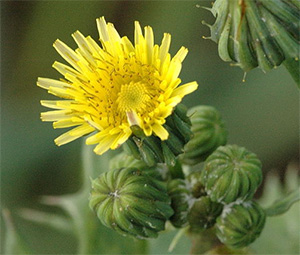 Weeds grow on agricultural lands, and in addition to the harm from reducing the yield and quality of agricultural products, they are also dangerous because some of their species are poisonous.
Weeds grow on agricultural lands, and in addition to the harm from reducing the yield and quality of agricultural products, they are also dangerous because some of their species are poisonous.
An admixture of poisonous weed seeds in the harvest may cause poisoning of people and animals.
Even baked bread can be dangerous if, during harvesting, grains, for example, trichodesma hoary or heliotrope pubescent, were collected along with wheat grains.
Animal products are poisonous by nature
These products include:
- marinka caviar;
- milt and caviar of barbel fish;
- puffer fish;
- some shellfish;
- some other types of fish.
Marinka caviar
This fish lives mainly in lakes of Central Asia. You can use it, but you need to understand that some caution is required when cutting.
Barbel milk and caviar
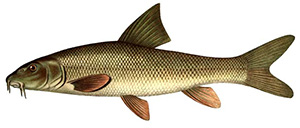 The barbel lives in large rivers, such as Volga, Dnieper and others. It can be prepared at home, but the only requirement is to be meticulous when cutting it.
The barbel lives in large rivers, such as Volga, Dnieper and others. It can be prepared at home, but the only requirement is to be meticulous when cutting it.
The belly should be ripped open carefully, and all contents must be disposed of, down to the black film that covers the abdominal cavity, since it is also very poisonous.
Pufferfish
 Tetrodotoxin is found not only in the liver, game and skin of the pufferfish, but also in the muscles themselves. Many Asian chefs take it upon themselves to prepare this exotic dish, but it requires not only careful processing, but also a certain period of the year to catch it. Therefore, it is better not to take risks and eat fish from the pufferfish family.
Tetrodotoxin is found not only in the liver, game and skin of the pufferfish, but also in the muscles themselves. Many Asian chefs take it upon themselves to prepare this exotic dish, but it requires not only careful processing, but also a certain period of the year to catch it. Therefore, it is better not to take risks and eat fish from the pufferfish family.
Some types of shellfish
It is known that mollusks pass water through themselves, thereby filtering it. It is not possible to catch them for consumption all year round, because during high tides they are infested with dinoflagellates that secrete saxitoxin.
This toxin is invulnerable to any cooking, especially since shellfish are usually cooked for only a short time.
Symptoms are characterized by local paralysis literally 5–40 minutes after eating, for example, oysters, mussels and scallops; paralysis of the mouth and nasolabial triangle on the face may appear. You should seek help immediately, because as soon as the toxin reaches the respiratory center, it is instantly blocked and death occurs.
Poisoning with toxic products under certain conditions
Products that are poisonous under certain conditions are also divided into groups of plant and animal origin.
Plant products are poisonous under certain conditions
TO plant products poisonous under certain conditions include:
- bitter kernels of stone fruits;
- raw beans;
- sprouted potatoes.
Bitter stone fruit kernels
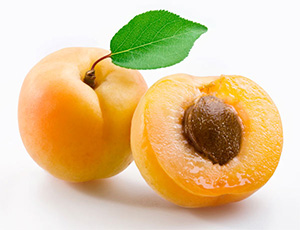 It's no secret that the bitter kernels of kernels, for example, of apricot or peach, are very useful, as they contain microelements that are simply necessary for the normal functioning of the body. But few people know that they are also conditionally poisonous. They contain the glycoside amygdalin.
It's no secret that the bitter kernels of kernels, for example, of apricot or peach, are very useful, as they contain microelements that are simply necessary for the normal functioning of the body. But few people know that they are also conditionally poisonous. They contain the glycoside amygdalin.
In small quantities, it causes weakness and mild nausea, appearing after about 4–10 hours. A person who has eaten a small handful may not feel it. In case of moderate poisoning, the symptoms will worsen somewhat and become more pronounced, vomiting, loose stools, and headache will appear.
After consuming 250–300 grams of bitter almonds or seeds, severe poisoning will occur, and the symptoms will be much more serious:
- cyanosis of the skin;
- convulsive syndrome;
- severe shortness of breath;
- acute feeling of lack of air.
Death occurs as a result of blockage of the respiratory center.
Raw beans
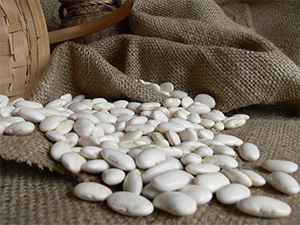 White beans are considered the most poisonous. The toxic substances of this plant have not yet been sufficiently studied, but it is known that when thoroughly cooked they disintegrate and do not cause any harm to the body.
White beans are considered the most poisonous. The toxic substances of this plant have not yet been sufficiently studied, but it is known that when thoroughly cooked they disintegrate and do not cause any harm to the body.
But if you eat raw beans or bean flour, you may experience vomiting, diarrhea and severe nausea. The only means of assistance is gastric lavage. There are no known deaths to date.
Sprouted potatoes
Sprouted potatoes accumulate the toxin glycoalkaloid solanine, which causes severe food poisoning.
Nausea, depression of consciousness, vomiting, severe weakness and other symptoms of gastroenteritis may occur. When consumed large quantity cases of death as a result of dehydration and heart failure cannot be excluded.
Animal products are poisonous under certain conditions
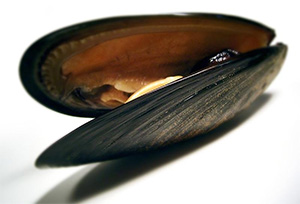 These products include:
These products include:
- liver, caviar and milt of burbot, pike;
- mussels;
- honey collected from poisonous plants.
Liver, game, fish milk
Although these types of fish are classified as causative factors of non-microbial poisoning under certain conditions, the toxicity of these fish is highly controversial, since in some cities liver and caviar are consumed in large quantities.
It is known that poisonous properties appear only in those individuals that are considered old or stored in inappropriate conditions. Freshly caught fish is almost never poisonous.
Honey from poisonous plants
Food poisoning of a non-microbial nature can also occur when consuming everyone’s favorite honey. The thing is that when collecting pollen, bees do not distinguish between plants, collecting from all the ones they come across. If there are a lot of poisonous plants in the area, then honey definitely cannot be used.
Food poisoning of non-microbial origin is sometimes impossible to predict. In order to protect yourself from them, you should carefully monitor what is to be consumed, that is, do not consume questionable products, and at the first symptoms, seek qualified advice. medical care. Often, time spent on self-medication greatly reduces the possibilities of rational therapy.











Surveyor. Who is a surveyor? Description of the profession. Profession surveyor Surveyor training
Magellanic clouds: who are they?
Pepper Steak Sauce Creamy Pepper Sauce
How to create a competent portfolio for a designer
If you dreamed that a house burned down - interpretation of the dream according to the dream book